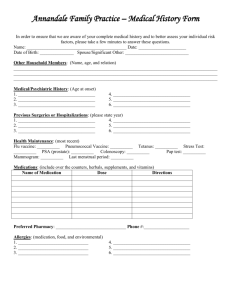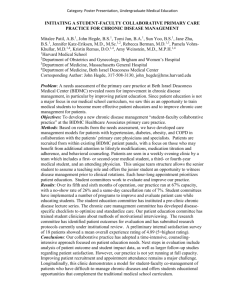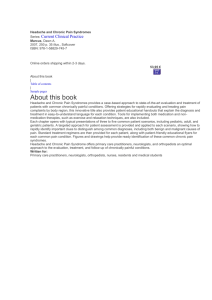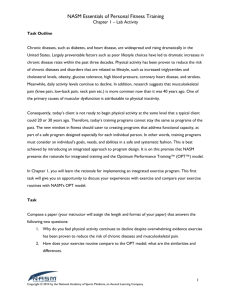Supporting children with chronic medical conditions in the
advertisement
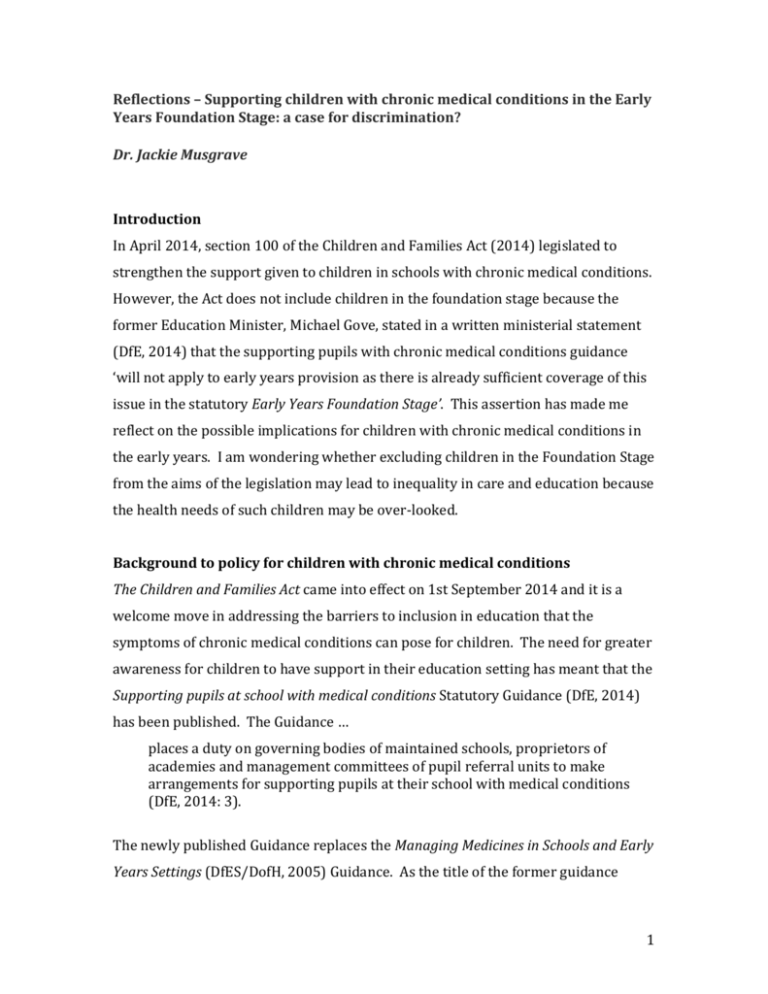
Reflections – Supporting children with chronic medical conditions in the Early Years Foundation Stage: a case for discrimination? Dr. Jackie Musgrave Introduction In April 2014, section 100 of the Children and Families Act (2014) legislated to strengthen the support given to children in schools with chronic medical conditions. However, the Act does not include children in the foundation stage because the former Education Minister, Michael Gove, stated in a written ministerial statement (DfE, 2014) that the supporting pupils with chronic medical conditions guidance ‘will not apply to early years provision as there is already sufficient coverage of this issue in the statutory Early Years Foundation Stage’. This assertion has made me reflect on the possible implications for children with chronic medical conditions in the early years. I am wondering whether excluding children in the Foundation Stage from the aims of the legislation may lead to inequality in care and education because the health needs of such children may be over-looked. Background to policy for children with chronic medical conditions The Children and Families Act came into effect on 1st September 2014 and it is a welcome move in addressing the barriers to inclusion in education that the symptoms of chronic medical conditions can pose for children. The need for greater awareness for children to have support in their education setting has meant that the Supporting pupils at school with medical conditions Statutory Guidance (DfE, 2014) has been published. The Guidance … places a duty on governing bodies of maintained schools, proprietors of academies and management committees of pupil referral units to make arrangements for supporting pupils at their school with medical conditions (DfE, 2014: 3). The newly published Guidance replaces the Managing Medicines in Schools and Early Years Settings (DfES/DofH, 2005) Guidance. As the title of the former guidance 1 suggests, the information included in the guidance was aimed at schools and early years settings: therefore, children from birth-to-18-years were included in the aims of the guidance. The previous guidance contained comprehensive information about the management of medicines for children with anaphylaxis, asthma, diabetes and epilepsy, because these are ‘the medical conditions in children that most commonly cause concern in schools and settings’ (DfES/DofH, 2005: 25). In addition, the guidance contained useful information and practical advice about these conditions. Some of this approach has been replicated in the ‘supporting pupils’ guidance. However, as previously stated, the new Guidance does not apply to children in the EYFS. Gove’s claim that there is sufficient coverage in the EYFS may mean that it is assumed that there is adequate awareness that young children’s care and education are inextricably linked and therefore, practitioners will adopt an holistic approach to planning the needs of children with chronic medical conditions. However, key to practitioners’ ability to plan appropriately is the need for them to be able to access training and acquire knowledge about the complexities associated with managing chronic conditions. Therefore, I feel that this issue requires further reflection to explore whether the aims and principles of the EYFS (especially as the previous DfES/DofH guidance, which included early years settings) are explicit enough and adequate to meet the needs of children with chronic medical conditions. Given that the new guidance is aimed at giving state-maintained school-aged children legal protection to be supported with managing their medical condition, this means that settings that are not state-maintained are not legally obliged to support children aged birth-five-years with chronic medical conditions. Specifically, children aged birth-two-years old who are in private, voluntary or independent (PVI) early years settings will not be included in the aims of the guidance, although two-year-old children who are in schools are likely to be included in the aims of the supporting pupils guidance, even though they will be taught the foundation stage framework. This may mean that young children in PVIs with such conditions may be discriminated against and may be unintentionally excluded from aspects of their ECEC. The exclusion of children under the age of two 2 is of concern because chronic medical conditions can have serious implications for children’s long-term health and well-being. Chronic medical conditions There are many different chronic medical conditions: some conditions are complex to manage and may mean that children have special educational needs. However, chronic conditions such as anaphylaxis, asthma, diabetes and eczema affect large numbers of children and these conditions are prevalent in western countries of the world. For example, 11% of children are estimated to have eczema, (NICE, 2007) and this condition is the most common reason for children under the age of two consulting a family doctor. It is important to note that a child having a diagnosis of one, or possibly more, of these conditions does not necessarily mean that s/he will be regarded as having an SEN. The symptoms of these conditions can be underregarded and over-looked. It is because chronic medical conditions are on-going that the symptoms can have a significant impact on children’s lives, to the extent that such symptoms can create barriers to accessing education. Comparing guidance to support children with chronic medical conditions The EYFS states ‘the provider must promote the good health of children attending the setting’ (DfE, 2014: 25). In addition, there is a statement that ‘children learn best when they are healthy’. However, the guidance does not acknowledge that the symptoms of chronic medical conditions can make a child feel unhealthy and possibly impact upon their education. Neither does the EYFS highlight the role of practitioners in keeping children with chronic medical conditions healthy. In contrast, the ‘supporting pupils at school with medical conditions guidance’ aims to … ensure that all children with medical conditions, in terms of both physical and mental health, are properly supported in school so they can play a full and active role in school life, remain healthy and achieve their academic potential (ibid: 5). There is an explicit statement about the statutory requirement in the EYFS to support and include all children, but it does not specify the need for children with 3 chronic medical conditions to be supported, whereas, the supporting children with medical conditions at school guidance makes explicit statements about the potential exclusive effects of the symptoms of such chronic conditions on children’s education. The Guidance states that: Pupils at school with medical conditions should be properly supported so that they have full access to education, including school trips and physical education (p4). The aim is to ensure that all children with medical conditions, in terms of both physical and mental health, are properly supported in school so that they can play a full and active role in school life, remain healthy and achieve their academic potential (p5). One aspect of the EYFS that goes some way to addressing the needs of children with chronic medical conditions is the guidance about the provision of medicines. There is a statutory requirement for practitioners in PVI settings to administer medication for children and guidance is given about policies and procedures for administration. However, the supporting pupils’ guidance has explicit information about the importance of careful management of medication such as insulin. It also includes specific guidance about access to adrenaline (for treatment of anaphylaxis) so that it is available in the event of an emergency. Therefore, the supporting pupils guidance makes clearer links between the place of medication in minimising the effects of chronic medical conditions, as well as identifying the role of staff in managing medicines. Research focus: children with chronic medical conditions in ECEC The potential negative and exclusive effects of the symptoms of chronic medical conditions on children’s education has been largely under-reported by educational researchers. A notable exception is a study by Mukerjee, et al. (2000), which researched how teachers included primary and secondary school aged children with diabetes and asthma and eczema. Their findings concluded that teachers are a major source of support for such pupils, but the extent and quality of this support 4 varied widely. However, there remains a dearth of research about the effects of chronic medical conditions on ECEC. A small-scale research study I conducted for my doctoral thesis (Musgrave, 2014) examined some of the considerations and challenges that practitioners needed to address in order to implement the aims and principles of the EYFS for children with chronic medical conditions. The following section gives examples of how practitioners adapt the environment and support young children to cope with chronic medical conditions. Considerations and challenges for early childhood education and care This section focuses on two important findings from the study. Firstly, it illustrates the importance of practitioners having knowledge and training about how to manage chronic medical conditions. Secondly, it reports some of the findings including examples of innovative practice in adapting activities given by the practitioners who participated in the study. Knowledge and training The findings from the study found that practitioner knowledge and training about the symptoms of chronic medical conditions was important. Such knowledge and training meant that practitioners could adapt activities to include children with these conditions. This happened in innovative and creative ways. However, the findings suggested that practitioners obtained their knowledge and training in ways that required high levels of willingness from practitioners. For example, some practitioners invested time in searching for information from charities associated with the condition in order to understand the implications of the condition. Practitioners obtained training by using their previously developed network of contacts; some contacts had been made as a result of having contact with health professionals as a result of having other children with medical needs in the setting. In more than one instance, training was given by parents to practitioners about aspects of children’s medical care. For example, one parent taught the staff how to use a blood sugar monitoring kit to take samples of blood from a child with diabetes. The blood readings were then interpreted by practitioners, in discussion with the 5 parents, to calculate carbohydrate and insulin intake, with the amount of physical activity that a child was participating in. The findings from this study indicated that practitioners were effective in showing strong leadership in obtaining knowledge and training about managing chronic medical conditions. However, their training was obtained through informal contacts. These examples convey some of the complexities that practitioners address in managing children’s chronic medical condition(s). This study reinforced the importance of practitioners working with parents to gain their knowledge and training. However, it is important to bear in mind that professional training and knowledge is also vital, but accessing training for PVI settings may be challenging. Adapting activities The practitioners in the study demonstrated innovative practice in how they adapted activities for children with chronic medical conditions. For example, Freddie was 34-months old and had widespread eczema on his hands. The eczema symptoms could be provoked by contact with some substances and he would then be in pain because of intense itching, his hands often bled and, consequently, he would be distracted from engaging with activities. Therefore, reducing contact with substances that provoked the symptoms meant that he was not in pain and could engage with learning activities. ‘Maria’, Freddie’s key person described how she adapted a sensory activity for him: We had shaving foam the other week and we had it on trays and we let the children, particularly the 2-3-year olds, explore it and my colleague was doing it with me and said “oh, what about Freddie’s skin?” So I said “put some Clingfilm over it and do it quite loosely so that he’s not messing with the foam but he can poke it and press it and feel that it’s soft and do what the other children are doing, not the wetness, but he can still explore it in that way. This is just one example of practitioners’ innovation: however it was not only sensory play that needed consideration. Practitioners in the study described how they had to consider the provision of outdoor play for children with asthma because symptoms and attacks can be provoked by physical activity, such as running. The 6 manager in a setting that participated in the research explained how administering a puff of inhaler to a child with asthma helped to reduce the chance of him becoming wheezy. She said, “The puff of inhaler meant that he avoided symptoms and could participate in football practice”. The understanding of the importance of this intervention links to previous comments about the importance of practitioners having access to training and knowledge about managing chronic medical conditions. Proposals So far, I have attempted to give a flavour of how the symptoms of chronic medical conditions can impact upon young children’s ECEC. I would argue that there is an urgent need for children in the early years to have the same legislative protection that is being offered to children over the age of five years for the following reasons: All children aged birth-to-5-years have greater dependency on the adults in ECEC settings because of age and stage of development and the symptoms of chronic medical conditions increase the need for practitioners to support them in accessing ECEC. The symptoms of chronic medical symptoms are an additional consideration for practitioners who are planning inclusive education in the foundation stage. The ‘supporting pupils with medical conditions’ guidance includes explicit information about how symptoms can impact on inclusion. However, the EYFS is not explicit about the exclusive impact of the symptoms of chronic medical conditions on young children’s ECEC. The findings from my small-scale research study suggest that chronic medical conditions can have profound effects on the lives of children. However, early years practitioners who are knowledgeable and have access to suitable training are wellplaced to support young children and can help to mitigate the negative effects of chronic medical conditions. Therefore, the exclusion of young children from having the legal support for their chronic medical conditions should be addressed, in order 7 to reduce the possible discriminatory effect on young children. I – and TACTYC – welcome your thoughts about this issue. References Department for Education and Skills and Department of Health (2005) Managing Medicines in Schools and Early Years Settings. London: DfES. Department for Education (2014) Supporting pupils at school with medical conditions. Available from https://www.gov.uk/government/uploads/system/uploads/attachment_data/fil e/306952/Statutory_guidance_on_supporting_pupils_at_school_with_medical_co nditions.pdf accessed 4 August, 2014. Department for Education (2014) Michael Gove Written Ministerial Statement: Children and Families Bill – Duty and statutory guidance to support children with medical conditions. Available from http://www.parliament.uk/documents/commons-voteoffice/October%202013/21%20October/3-Education-ChildrenFamiliesBill.pdf accessed 14 May, 2014. Mukherjee, S., Lightfoot, S. and Sloper, P (2000) The inclusion of pupils with a chronic health condition in mainstream school: what does it mean for teachers? Educational Research, 42(1): 59-72. Musgrave, J. (2014) How do practitioners create inclusive environments for children with chronic health conditions? An exploratory case study. Thesis for Doctor of Education, University of Sheffield. Available from http://etheses.whiterose.ac.uk/6174/1/Jackie%20Musgrave%20%20Final%20Thesis%20incl%20Access%20Form%20for%20submission%2019 -5-14.pdf accessed 6 August, 2014 National Institute for Health and Clinical Excellence (NICE) (2007) Atopic Eczema in Children. Management of Atopic Eczema in Children for Birth up to the age of 12 Years. Retrieved 8 January, 2008 from: www.nice.org.uk 8


